Carnegie Libraries in the Cowboy State
Cowboy Carnegies Campaign
The Cowboy Carnegies campaign seeks to raise awareness of Wyoming’s Carnegie library buildings and promote their preservation and continued use.
AHW recognizes the importance of the remaining Carnegie buildings, constructed as centers of community learning and gathering, and serving as the site of many formative experiences for Wyoming’s citizens. The Carnegie buildings are architectural gems as well, created with a sense of dignity and elegance that added to a community’s character when they were built in the early twentieth century.
Communities today remain enamored with their Carnegie buildings, but there are still threats to their continued existence, and regrets over those that have been demolished. AHW hopes to help preserve them as vital elements of the state’s architectural and cultural landscape.
History
Andrew Carnegie

As a boy of 13, Andrew Carnegie immigrated from Scotland to the United States in 1848 with his parents and younger brother. They settled in Allegheny City, Pennsylvania. Rather than attending school, Carnegie worked to help support the family—first at a textile mill, then as a messenger boy, and eventually with the Pennsylvania Railroad. But, as he reported in his memoirs, he educated himself at a private library owned by a Colonel James Anderson who allowed local boys access to his collection of books on Saturday afternoons.
Carnegie’s business interests eventually coalesced around the development of steel needed for the construction of railroad bridges and the burgeoning skyscrapers in American cities. In 1875 he opened a steel mill in Braddock, Pennsylvania, and a little less than 20 years later, in 1892, he formed the Carnegie Steel Company. In 1901, as one of the wealthiest men in the nation, he sold his steel business to J. P. Morgan for almost $500 million (it later became U.S. Steel) and turned his energy toward philanthropy.
One commentator called Carnegie the most contradictory of the robber barons: he supported workers’ rights, but destroyed unions, and when he acquired the largest fortune in US history, he tried to give it away. Andrew Carnegie died in 1919.
Click on an image and hover to read more.

Date granted: March 18, 1904
Date completed: 1905
Grant Amount: $12,500
Date demolished: 1974
Libraries in Sheridan date back to 1883. The city’s founder, John D. Loucks, opened a small library in the upstairs of a small building downtown. Sheridan City Library followed this original library, opening in 1903. The library received a $12,500 grant from the Carnegie Public Library fund in 1904. President of the Sheridan Commercial Club Edward Gillett was the correspondent to Andrew Carnegie. In a letter dated April 1904 that responded to the reception of the grant, Mr. Gillett mentions that the selected site for the new library was very close to the center of town. This detail is particular interesting because it upholds the value that libraries, particularly libraries in Andrew Carnegie’s vision, should be at the physical and ideological center of a community. The new Sheridan Carnegie Public Library opened August 1, 1905. The library was torn down in 1974 after the new Sheridan Margaret S. Fulmer Memorial Public Library opened; Harry B. Fulmer pledged $300,000 to the construction, and it was dedicated to his late wife.
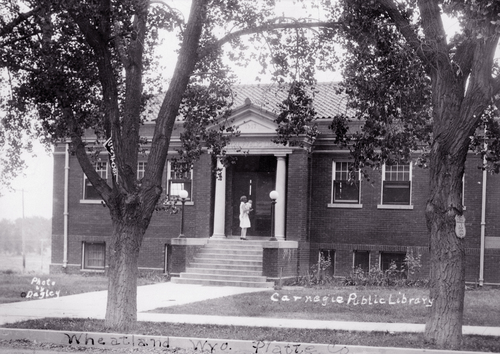
Date granted: May 15, 1916
Date completed: 1917
Grant Amount: $12,500
Current use: Library
A group of local women formed the Wheatland Library Association in 1896, which eventually had a building and book collection. They were deeded to Platte County in 1914, which then formed its own library board, and established traveling libraries in outlying post offices. The county received Carnegie funding for a permanent building in 1916.
The 1965 remodeling and addition enclosed the original Carnegie building on three sides, but the north side is still visible.

Weston County Library, Newcastle
Date granted: February 20, 1911
Date completed: 1911
Grant Amount: $12,500
Architect: Charles A. Randall
Current use: Library
In 1909 the Twentieth Century Club of Newcastle formed a library club, which eventually resulted in the receipt of a $12,500 Carnegie grant in 1911. Both the library and the courthouse next door were designed by local architect Charles A. Randall. When an addition to the library was built in 1983 the original front door and steps were removed. The current librarian used the library as a child, and has a collection of check-out cards with her name on them. The library is a contributing structure in the Newcastle Commercial District on the National Register of Historic Places.

Date granted: June 29, 1908
Date completed: 1909
Grant Amount: $17,500
Date demolished: 1954
The Big Horn County Library was created in 1907 by the Book Lovers’ Club, an organization created by a group of women in Basin in 1906. It first opened to the public in the spring of that year in the Big Horn County Bank building. The library was open Tuesdays, Thursdays, and Saturdays from 2 p.m. to 5 p.m. and from 7 p.m. to 8 p.m. On June 29, 1908, the Big Horn County Library received a $17,500 Carnegie Public Library Building grant. The cornerstone was laid September 27, 1909, and the dedication became a community-wide event. Members of the Basin Lodge of Odd Fellows, the Basin Band, and members of Woman’s Club led a procession to the building site, followed by citizens of the community.
The students of Basin High School raised funds to purchase a stained glass window for the Carnegie LIbrary. It was salvaged when the building was demolished in 1954 and installed in the new library behind the circulation desk.
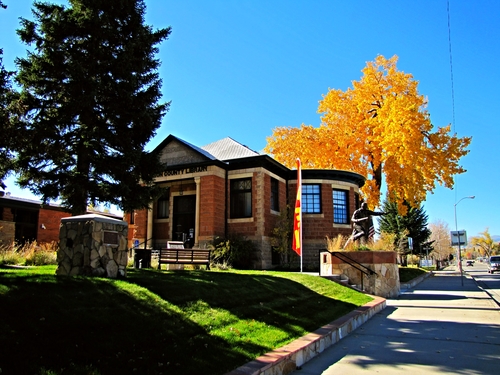
Now the Jim Gatchell Memorial Museum
Date granted: January 14, 1909
Date completed: 1909
Grant Amount: $12,500
Current use: Museum
The Johnson County Library received $12,500 in Carnegie funding for its building in 1909, and a portion of the county courthouse grounds was donated as the site. The Neoclassical-style library is built of two colors of native, rock-faced sandstone. Buff-colored sandstone is used for the raised foundation and trim, while the walls are red sandstone. The spacious main floor is accessed by the requisite staircase framed by columns. A special feature of this building is a semi-circular bay, which was originally topped by a balustrade.
After the Carnegie library closed in 1987 and the Johnson County Library moved to a new building, the Carnegie building was incorporated into the Jim Gatchell Memorial Museum, which was established next to the courthouse in 1957. In 2006 the two buildings were connected, and today the Carnegie building serves as the main entrance to the museum. It the only Wyoming Carnegie listed independently on the National of Historic Places. In Craig Johnson’s Longmire books, the fictional sheriff has his office in Buffalo’s Carnegie building.

Date Granted: February 13, 1906
Date Completed: 1910
Amount of Grant: $10,000 + $3,000
Architect: C. A. Randall
Date demolished: 1970
In June of 1905, Casper Mayor Wilson S. Kimball wrote to Andrew Carnegie, requesting a grant to build a library in Casper. In his letter, he wrote that “This is essentially a range live-stock country, in which many men are constantly going to and coming from town. A Carnegie Library here would benefit a class that are seldom benefitted by such institutions, and would afford a quiet, wholesome and instructive resort of a character that are too scarce in these western range towns.” The community received $10,000 to construct a library. C.A. Randall designed the building and Charles Galusha was awarded the $10,400 construction contract.
Two years later, however, the funds were depleted but the building was still unfinished. Even an additional $3,000 donation from Carnegie was not enough to complete the job. In frustration, the Casper Town Council gave the building and the city-owned property to Natrona County in 1909. The county commissioners gave the Natrona County Public Library Association control of the Carnegie library building and the $2,500 that had accumulated from the 1903 mil levy. Unfortunately, state statute prohibited the use of the mil levy to complete construction. Finally, Wyoming’s attorney general decided that while tax revenues couldn’t be used to finish the library building, they could be applied to “repairs” of the building provided the community agreed. Tired of the endless wrangling, the community did agree and “repairs” to the unfinished building commenced.
The white-domed Carnegie Library finally opened to the public on May 20, 1910. Mrs. Sarah Place, the new librarian, welcomed people into a building with no heat, no plumbing, almost no fixtures and very few books. No sidewalk led up to the new brick building with its fine dome; to reach the door people had to pick their way across a dirt lot through heaps of building materials and rubbish.
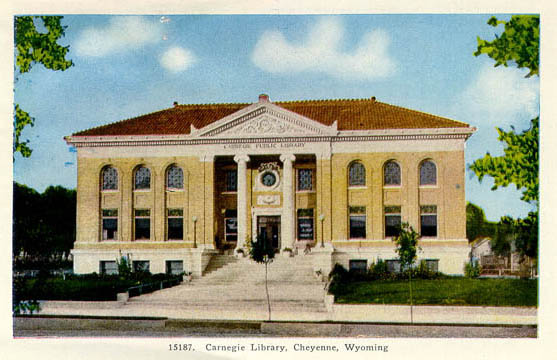
Date Granted: December 27, 1899
Date Completed: May 19, 1902
Amount of Grant: $50,000
Architect: Patton, Fisher and Miller from Chicago; supervising architect William Dubois.
Date Demolished: 1971
Cheyenne’s first library was located in the Central School in a 20 by 30 foot room. In 1900, a building committee for a new library was established that included Joseph M. Carey, Judge John Riner, U.S. Attorney Timothy F. Burke, banker Henry G. Hay, and Union Pacific attorney John W. Lacey. Robert C. Morris, son of Esther Hobart Morris, served as president of the Library Auxiliary Association. The Cheyenne Woman’s Club helped raise money for furniture and equipment for the new library, which included a room for the Woman’s Club meetings. Local legend asserts that Mrs. Andrew Carnegie gave $500 to help furnish that room.
The architectural firm of Patton, Fisher, and Miller was chosen primarily because Morris admired the Academy of Sciences building in Lincoln Park, Chicago, and wanted something similar for the Cheyenne Carnegie library. William Dubois served as supervising architect for the project. He found Cheyenne so congenial that he set up his own practice there, and went on to become one of Wyoming’s most prolific and creative architects..
When the new facility was finally finished, it spanned three floors, with a 240-seat auditorium, a stack room with a 50,000 volume capacity, an art gallery, and two club rooms with space for meetings and quiet reading. The exterior was dominated by a massive staircase leading to the entry, which many who visited as children still recall very clearly. In the words of one Cheyenne resident who visited the library as a child, “When you walked up that staircase, you just sort of got this majestic feeling, like you were going someplace extremely important.”

Date granted: April 13, 1914
Date completed: May 9, 1916
Grant Amount: $15,000
Date demolished: 1965
The Cody Library was first formed by the Woman’s Club of Cody in 1906. The first location for the library was in a small stone building about 20 square feet in area. It was one room, and the back wall was actually not really a true wall, just a few boards nailed up where a wall should be. The Carnegie Public Library Building Grant was first pursued in 1910, but the town was too small at that time to qualify. It also was not a county seat, which at that time was also a qualification for eligibility; in 1910, what would become Park County was still a part of Big Horn County.
In 1911, Park County split from Big Horn County, and in 1914 the Park County Commissioners appointed a board for a public library system. The city council immediately reapplied for a Carnegie Public Library Building Grant. The local correspondent to the Carnegie Foundation for Cody was Reverend Morten Joslin. In a letter to Carnegie’s secretary James Bertram, Joslin suggested the possibility of contacting Colonel W.F. Cody, who was visiting New York City at that time. It’s possible that the famous “Buffalo Bill” himself had a hand in establishing a Carnegie library in Cody. The application was successful and the town received a $15,000 grant. The library opened in 1916. The building was regretfully demolished in 1965 to make room for the new Park County Library building.

Date Granted: July 20, 1908
Date Completed:1911
Amount of Grant: $10,000
Date Demolished: 1966
The first library in Douglas opened in 1905 in a building on Center Street, then moved to a room in the county courthouse. In 1908, the town of Douglas received a grant of $10,000 for the construction of a library building, with the town providing a building site and ongoing maintenance and operating costs. Citizens of Douglas contributed money towards the purchase of the lot at 300 Walnut Street. The new Carnegie Library building was officially accepted in a formal ceremony on April 12, 1911.
The Carnegie building was demolished in September 1966 to make way for a new library building. The centennial celebration of the Converse County Library in 2005 included a commemorative coffee mug featuring an image of the original Carnegie building.

Now the Unita County Museum and Evanston Chamber of Commerce
Date Granted: February 1903
Date Completed: 1906
Amount of Grant: $11,000
Architect: Albert Randolph Ross of New York
In 1902, the citizens of Evanston petitioned Andrew Carnegie for a library grant, but their request was denied since the community did not meet Carnegie’s minimum population requirement. So U. S. Senator Clarence D. Clark, whose home was in Evanston, wrote to Carnegie, explaining that the library would serve the entire population of the county, not just those who lived in Evanston. It’s hard to resist an appeal from a U.S. Senator – and Evanston got its library grant in February 1903.
The Classical Revival style building was constructed on a lot donated by the Union Pacific Railroad adjacent to the passenger depot. With books supplied by the local Women’s Club and a staff of one, the handsome brick library opened in May 1906. The building served as the public library for 80 years. One of the most vivid memories of people who used the library over the years was the piano in the lower level of the building , where many young residents performed recitals. It remains a mystery how the instrument was wrestled down the narrow stairs!
The newly established Uinta County Museum moved into the building in 1987, sharing it with the Evanston Chamber of Commerce. In 2007, an architecturally sensitive addition to the rear of the building was constructed to provide a new, accessible front entrance and additional museum exhibit and storage space. Three of the tall narrow windows from the back of the original building were salvaged and incorporated into the new structure. The Carnegie building is included in the Downtown Evanston Historic District.

Date Granted: December 8, 1905
Date Completed: 1907 (dedicated July 4)
Amount of Grant: $20,000
Architect: William Dubois
In October 1895, a library was established in Green River and was located on the first floor of the school (now the Masonic Temple), through the efforts of Robert C. Morris and T.S. Taliaferro, Jr.. The Carnegie library was dedicated on July 4, 1907, with 500 citizens attending the ceremonies. The first county librarian was Elizabeth Moriarty and she served until World War I. Her starting wage was $10 per year. When the library celebrated its 50th anniversary on July 4, 1957, they had one employee who worked there the entire 50 years, custodian William Hutton, Jr.
When Green River’s new Sweetwater County Library opened in 1980 the Carnegie building was used to house the county circuit court, but it is now vacant. It is included in the Green River Commercial District on the National Register of Historic Places.
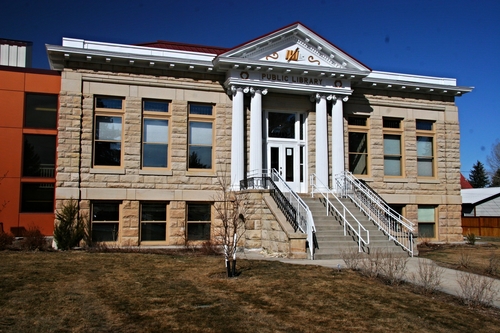
Date granted: November 27, 1906
Date completed: 1907, opened March 1, 1909
Grant Amount: $15,000
Current use: Library
When the Fremont County Library opened, it had a total of 427 books, and they all had to be used within the library because a catalog wasn’t completed until 1911. Library materials couldn’t be checked out until the catalog was finished. However, its popularity grew quickly, as did the town. Many correspondents in search of Carnegie funding talked about the expansion of their towns in terms of population growth, diversity, and industry. In a 1906 letter from Lander correspondent S. Conant Parks to Andrew Carnegie’s secretary James Bertram, Parks said, “Replying to your inquiry on the 23rd, I beg to state that the last Federal Census gives the population of Fremont County, which is to receive the Library referred to, as 5357, including 1691 Indians. The present estimated population, exclusive of Indians is about 5000. It is expected that the population will rapidly increase during the next few years with the advent of the railroad and the opening this summer of the Shoshone Indian Reservation.” Just as the people of Lander predicted, the growth of the town necessitated the construction of an annex in 1976 to accommodate the growing community; a second addition was completed in 2009 and now serves as the library’s main entrance. The original Carnegie building houses office and meeting space while the newer annexes store all the library materials. An exterior renovation of the old building was undertaken in 2012.

Now the City of Laramie Office Annex
Date granted: January 2, 1903
Date completed: 1905
Grant Amount: $20,000
Current use: City offices
Laramie was the second Wyoming community to receive a grant from Carnegie for a library. The building was dedicated on January 22, 1906, and at the ceremony Aven Nelson said “in the early spring of 1902 I met in Cheyenne Mr. Robert C. Morris, whose name is so closely associated with and whose ideas as so ineradicably incorporated into the magnificent Carnegie Library Building in that city. The purpose that had for some months been forming in my mind, to try to secure for Laramie a similar benefaction, was greatly strengthened by his enthusiasm and encouragement.”
Because Laramie received a smaller grant than Cheyenne, the building has unique features as a result of making cost reductions during construction. One of these is that the front columns and exterior cornices are constructed out of cheaper and lighter metal instead of heavier, more expensive stone. The building was expanded in 1927 and remodeled in 1951, and in 1981 it was vacated when the library moved to a new building two blocks away. A human book brigade passed books from hand to hand down the street during the move, an event captured on a video that can be viewed on the library’s web site. The Carnegie building now serves as city office space and has been connected to the neighboring fire station. It is a contributing structure in the Laramie Downtown Historic District.
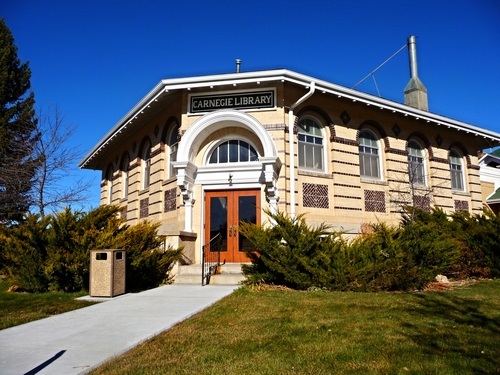
Date granted: May 8, 1914
Date completed: 1919
Grant Amount:$11,000
Architect: Elmer Ranck
Current use: Library
Lusk’s original library, the Stillman Library, named for the great-grandmother of the town’s founder, occupied three different sites until Carnegie funding was obtained for a permanent building. The original correspondent from Lusk was Mrs. Henry T. Gray, president of the Lusk Reading Club; many local libraries began as women’s clubs and literary organizations, although Carnegie required official correspondence to come from municipalities. Local residents made contributions for the purchase of the property and a local architect created the design. Originally called the Lusk Carnegie Library, the building was renamed the Niobrara County Library in 1976. The Lusk library is the only one in Wyoming with a corner entrance.
An addition was built in 1999 to provide handicapped access and add much needed space to the library. The exterior details, such as the arched windows outlined in darker brick, echo the original architecture and make for a unified whole. The library received a Historic Architecture Assistance Fund grant from the Alliance for Historic Wyoming in 2013 to study the need for restoring the windows and doors, and the window restoration was completed in 2015.

Now the Rock Springs Public Library & Fine Arts Center
Date Granted: December 13, 1907
Date Completed: 1910
Amount of Grant: $12,500
Current Use: Library and Arts Center
The Rock Springs City Library received a $12,500 Carnegie grant in December of 1907. The sandstone building designed in the Neoclassical style was completed and opened in 1910. Sweetwater County is the only one in Wyoming to have two Carnegie libraries, in Rock Springs and Green River.
Forty-four years later the first major remodel took place, followed by additional expansion in 1965. During the mid-1970s the building underwent extensive remodeling and expansion, including an addition which joined the old LDS church to the library. In the 1970s, the library and the Church of the Latter Day Saints were both encased in an aluminum and glass wrapper and joined across Blair Street to create the Rock Springs Library and Community Fine Arts Center. The building in included in the Downtown Rock Springs Historic District.
For one Rock Springs resident in the 1960s, “the Rock Springs library was my home away from home. I worked there during summers in high school (though the librarians often had to remind me that I wasn’t supposed to read the books as I was shelving them!)”

Date granted: April 3, 1917
Date completed: 1919
Grant Amount: $12,500
Current use: Government offices
Thermopolis was the last community in Wyoming to receive a Carnegie Public Library Building Grant. The Women of the West club formed a reading room in 1902. In 1904, the group of women began amassing books to stock their library, which was located the courthouse. By 1913, the need became apparent for a new building dedicated to the library. The library was granted by the Carnegie Foundation in 1917 and on September 12, 1919, the new Thermopolis Carnegie Library held its grand opening celebration. In 1962, a retired priest passed away and left behind a large amount of money to the county, and in 1966 a new library was completed with the priest’s gift. The Carnegie building was not torn down and was converted into city offices.
History of Carnegie Libraries
In 1876 the American Library Association was formed. In 1886, Carnegie would begin giving money to build free public libraries.
There would be two phases to this program, which have been referred to as the retail and wholesale phases. In the retail phase, which lasted from 1886-1896, he would give money to communities, usually where he had a business interest, to build a public library. Most of these would be located in Pennsylvania. In 1892, Carnegie would form Carnegie Steel.
In the wholesale phase, which lasted from 1898-1919, communities applied for a public library building grant. 1901 was a turning point for the library program. That was the year when Carnegie Steel was sold to J.P. Morgan for a mere $480 million. Carnegie also officially retired, the library program really took off. Instead of overseeing this philanthropic endeavor himself, Carnegie instead turned the program over to his private secretary, James Bertram. All of the correspondence would go through him. One side note, is both Carnegie and Bertram were members of the Simplified Spelling club. So all of the correspondence was written as such, which made for some interesting and sometimes confusing reading.
The program was revised as needed, especially during the first couple years, as new problems came to their attention, and learning from some of their early mistakes. At the beginning, citizens were asking Carnegie for a public library for their town, and Carnegie would say yes, only to find out later that the town officials either did want the library or did not want Carnegie’s money, or even for legal reasons. So they adapted as time went on.
There would be two criteria to receive a Carnegie Public Library Building Grant. First, the community
would have to supply a building site. For the most part, the building site would be located on Main Street or very close to it. In some cases, the site may also be near the railroad depot. This was important in some locations, as these communities were growing in population as more people were heading West, and if the town could boast that they had a public library all the better. Usually, the library would also be near the other government buildings. Since many of the main streets also had saloons, the libraries would be close by, but not too close.
The second criteria was that the community, using tax monies, fund 10% of the total grant received for maintenance. Remember the Carnegie Public Library Building grant was only for the building and the furniture. It did not include the books, the salary, and the general maintenance of the building. Bertram wanted to only deal with the library board and the city government (mayor/council). Bertram also preferred the correspondence be typed on official letterhead.
Written by Linda Waggener
Check out the map below to see where each library is located and how it is currently used if it still exists.


Is your library, museum, historical society, or organization interested in hosting the traveling exhibit or a lecture on Wyoming’s Cowboy Carnegies?
The exhibit is currently on long-term loan to the Wyoming State Library. Read more here.
Questions? Please call or email us.




